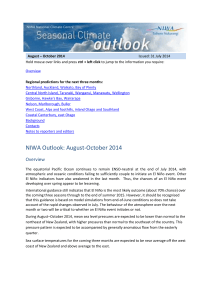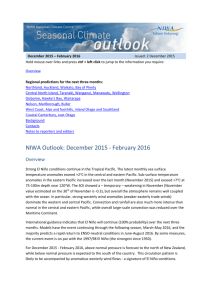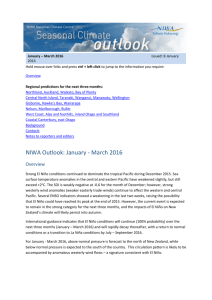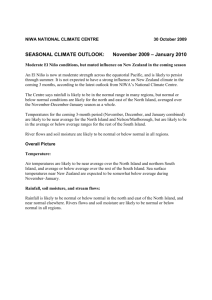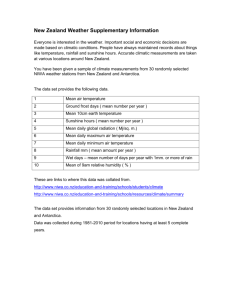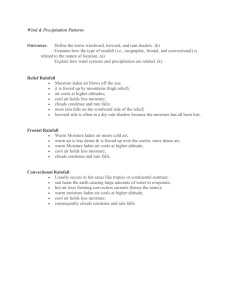SCO_Jan2015
advertisement
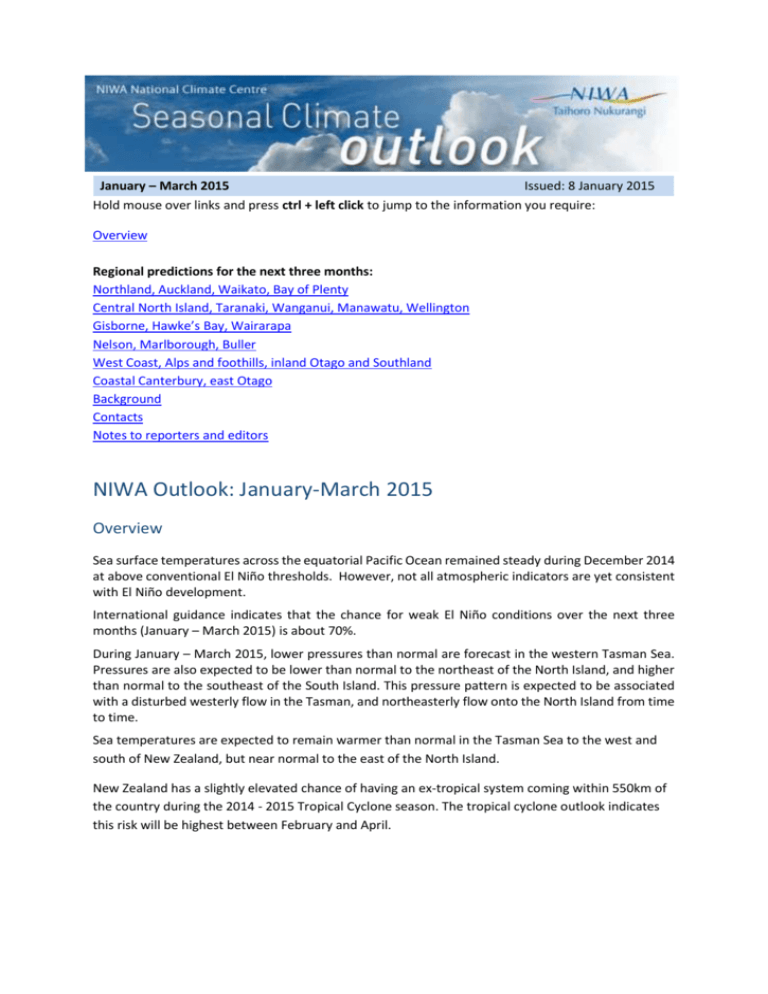
January – March 2015 Issued: 8 January 2015 Hold mouse over links and press ctrl + left click to jump to the information you require: Overview Regional predictions for the next three months: Northland, Auckland, Waikato, Bay of Plenty Central North Island, Taranaki, Wanganui, Manawatu, Wellington Gisborne, Hawke’s Bay, Wairarapa Nelson, Marlborough, Buller West Coast, Alps and foothills, inland Otago and Southland Coastal Canterbury, east Otago Background Contacts Notes to reporters and editors NIWA Outlook: January-March 2015 Overview Sea surface temperatures across the equatorial Pacific Ocean remained steady during December 2014 at above conventional El Niño thresholds. However, not all atmospheric indicators are yet consistent with El Niño development. International guidance indicates that the chance for weak El Niño conditions over the next three months (January – March 2015) is about 70%. During January – March 2015, lower pressures than normal are forecast in the western Tasman Sea. Pressures are also expected to be lower than normal to the northeast of the North Island, and higher than normal to the southeast of the South Island. This pressure pattern is expected to be associated with a disturbed westerly flow in the Tasman, and northeasterly flow onto the North Island from time to time. Sea temperatures are expected to remain warmer than normal in the Tasman Sea to the west and south of New Zealand, but near normal to the east of the North Island. New Zealand has a slightly elevated chance of having an ex-tropical system coming within 550km of the country during the 2014 - 2015 Tropical Cyclone season. The tropical cyclone outlook indicates this risk will be highest between February and April. Outlook Summary January – March 2015 temperatures are most likely (45% chance) to be in the above normal range in the west of the South Island, and likely (35-40%) to be near-normal or above normal in all other regions. January – March 2015 rainfall is likely (35-40% chance) to be in the near-normal or above normal range in North Island regions, most likely (50%) near-normal in the north of the South Island, and likely (40%) near-normal or below normal in all other regions of the South Island. January – March 2015 soil moisture levels are most likely (50% chance) to be below normal in the east of the South Island, likely (35-40%) near-normal or below normal in the north and east of the North Island, and most likely (45%) in the near-normal range in other regions. River flows are most likely (50% chance) to be below normal in the east of the South Island, and likely (35-45%) nearnormal or below normal in all other regions. Regional predictions for the December to February season Northland, Auckland, Waikato, Bay of Plenty The table below shows the probabilities (or percent chances) for each of three categories: above average, near average, and below average. In the absence of any forecast guidance there would be an equal likelihood (33% chance) of the outcome being in any one of the three categories. Forecast information from local and global guidance models is used to indicate the deviation from equal chance expected for the coming three month period, with the following outcomes the most likely (but not certain) for this region: Temperatures are equally likely (40% chance) to be in the near-average or above average range. Rainfall totals are likely (35-40% chance) to be in the above normal or near-normal range. Soil moisture levels and river flows are likely (35-40% chance) to be in the near-normal or below normal range. Other outcomes cannot be excluded. The full probability breakdown is: Temperature Rainfall Soil moisture River flows Above average 40 35 25 25 Near average 40 40 35 35 Below average 20 25 40 40 Central North Island, Taranaki, Wanganui, Manawatu, Wellington Probabilities are assigned in three categories: above average, near average, and below average. Temperatures are equally likely (40% chance) to be in the near-average or above average range. Rainfall totals are equally likely (40% chance) to be in the near-normal or above normal range. Soil moisture levels most likely (45% chance) to be in the near-normal range. River flows are about equally likely (40-45% chance) to be in the below normal or nearnormal range. The full probability breakdown is: Temperature Rainfall Soil moisture River flows Above average 40 40 20 15 Near average 40 40 45 45 Below average 20 20 35 40 Gisborne, Hawke’s Bay, Wairarapa Probabilities are assigned in three categories: above average, near average, and below average. Temperatures are about equally likely (35-40% chance) to be above average or average. Rainfall totals are equally likely (40% chance) to be in the near-normal or above normal range. Soil moisture levels and river flows are about equally likely (35-40% chance) to be in the near-normal or below normal range. The full probability breakdown is: Temperature Rainfall Soil moisture River flows Above average 35 40 25 25 Near average 40 40 35 35 Below average 25 20 40 40 Nelson, Marlborough, Buller Probabilities are assigned in three categories: above average, near average, and below average. Temperatures are equally likely (40% chance) to be in the near-average or above average range. Rainfall totals and soil moisture levels are most likely (45-50% chance) to be in the nearnormal range. River flows are equally likely (40% chance) to be in the near-normal or below normal range. The full probability breakdown is: Temperature Rainfall Soil moisture River flows Above average 40 20 20 20 Near average 40 50 45 40 Below average 20 30 35 40 West Coast, Alps and foothills, inland Otago, Southland Probabilities are assigned in three categories: above average, near average, and below average. Temperatures are most likely (45% chance) to be in the above average range. Rainfall totals are equally likely (40% chance) to be in the near-normal or below normal range. Soil moisture levels are most likely (45% chance) to be in the near-normal range. River flows are about equally likely (40-45% chance) to be in the below normal or nearnormal range. The full probability breakdown is: Temperature Rainfall Soil moisture River flows Above average 45 20 20 15 Near average 35 40 45 45 Below average 20 40 35 40 Coastal Canterbury, east Otago Probabilities are assigned in three categories: above average, near average, and below average. Temperatures are equally likely (40% chance) to be in the near-average or above average range. Rainfall totals are equally likely (40% chance) to be in the near-normal or below normal range. Soil moisture levels and river flows are most likely (50% chance) to be in the below normal range. The full probability breakdown is: Temperature Rainfall Soil moisture River flows Above average 40 20 15 15 Near average 40 40 35 35 Below average 20 40 50 50 Graphical representation of the regional probabilities Background Sea surface temperatures (SSTs) in the equatorial Pacific Ocean showed little change between November and December 2014, and thus have remained above the conventional El Niño threshold of +0.7 oC above normal. The subsurface ocean is also warmer than normal (+2-3 oC) at about 100 to 150 m depth in the eastern Pacific around 120oW. Despite oceanic anomalies showing signs of a weak El Niño, the atmosphere has not responded with patterns typically associated with El Niño conditions. The preliminary NIWA Southern Oscillation Index (SOI) for December 2014 is -0.7. This brings the three-month October-November-December value to -0.8. Strongly negative SOI values (less than -1) are typically associated with El Niño. There is also no significant convection or enhanced rainfall east of the Dateline, and no strong westerly wind anomalies, along the equatorial Pacific. The international guidance suggests the chances of El Niño developing over the January to March 2015 period is about 70%, a similar level to outlooks issued last month. For New Zealand, El Niño events are typically (but not always) associated with stronger and/or more frequent westerly winds. Such a climate pattern typically leads to drier conditions in eastern and northern areas and more rain in western areas of the country. The regional atmospheric circulation and rainfall outlook for January to March 2015 – as synthesized from various dynamical and statistical models – is not typical of El Niño conditions, even though low soil moisture levels have developed in eastern parts of New Zealand. Meanwhile, waters surrounding New Zealand are warmer than average to the west of the country and around the South Island, but cooler than average east of the North Island. Ocean models forecasts indicate that SSTs are likely to remain warmer than average in the Tasman Sea to the west and south of New Zealand, but near average to the east of the North Island. To find out more about normal conditions for this outlook period, refer to NIWA’s website, where daily updates on climate maps are available. Dry conditions have intensified over recent weeks in the east of both Islands, and also in central and southern Waikato. Even where normal to above-normal rainfall conditions are predicted over the next three months, these dry conditions are likely to linger for a while because of the high evaporation rate over the summer months. For comment, please contact Chris Brandolino, NIWA forecaster, NIWA National Climate Centre Tel (09) 375 6335, Mobile (027) 886 0014 Dr Brett Mullan, Principal Scientist, NIWA National Climate Centre Tel (04) 386 0508, Mobile (027) 294 1169. Notes to reporters and editors 1. NIWA’s outlooks indicate the likelihood of climate conditions being at, above, or below average for the season as a whole. They are not ‘weather forecasts’. It is not possible to forecast precise weather conditions three months ahead of time. 2. The outlooks are the result of the expert judgment of NIWA’s climate scientists. They take into account observations of atmospheric and ocean conditions and output from global and local climate models. The presence of El Niño or La Niña conditions and the sea surface temperatures around New Zealand can be a useful indicator of likely overall climate conditions for a season. 3. The outlooks state the probability for above average conditions, near average conditions, and below average conditions for rainfall, temperature, soil moisture, and river flows. For example, for winter (June–July–August) 2007, for all the North Island, we assigned the following probabilities for temperature: · Above average: 60 per cent · Near average: 30 per cent · Below average: 10 per cent We therefore concluded that above average temperatures were very likely. 4. This three-way probability means that a random choice would be correct only 33 per cent (or one-third) of the time. It would be like randomly throwing a dart at a board divided into three equal parts, or throwing a dice with three numbers on it. An analogy with coin tossing (a twoway probability) is not correct. 5. A 50 per cent ‘hit rate’ is substantially better than guesswork, and comparable with the skill level of the best overseas climate outlooks. See, for example, analysis of global outlooks issued by the International Research Institute for Climate and Society based in the US published in the Bulletin of the American Meteorological Society (Goddard, L., A. G. Barnston, and S. J. Mason, 2003: Evaluation of the IRI’s “net assessment” seasonal climate forecasts 1997–2001. Bull. Amer. Meteor. Soc., 84, 1761–1781). 6. Each month, NIWA publishes an analysis of how well its outlooks perform. This is available online and is sent to about 3500 recipients of NIWA’s newsletters, including many farmers. See www.niwa.co.nz/our-science/climate/publications/all/cu 7. All outlooks are for the three months as a whole. There will inevitably be wet and dry days, and hot and cold days, within a season. The exact range in temperature and rainfall within each of the three categories varies with location and season. However, as a guide, the “near average” or middle category for the temperature predictions includes deviations up to ±0.5°C for the longterm mean, whereas for rainfall the “near normal” category lies between approximately 80 per cent and 115 per cent of the long-term mean. 8. The seasonal climate outlooks are an output of a scientific research programme, supplemented by NIWA’s Capability Funding. NIWA does not have a government contract to produce these outlooks. Visit our media centre at: www.niwa.co.nz/news-publications/media-centre
